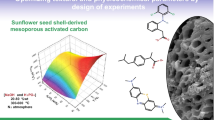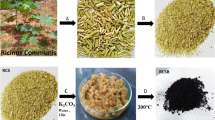Abstract
The search for renewable adsorbent materials has increased continuously, being the agro-wastes an interesting alternative. This work aimed to elucidate the mechanism of adsorption of Rhodamine B on crude and modified coconut fibers from aqueous systems and the feasibility of reusing the biosorbents. The chemical modification of crude coconut fiber was carried out by the organosolv process. The biosorbents were characterized by lignocellulosic composition, FTIR, TGA, WCA, SEM, nitrogen adsorption/desorption (BET-BJH), and pH of zero point of charge (pHPZC) analyses. The batch adsorption tests evaluated the effects of the adsorbent and adsorbate dosages, contact time, and temperature on Rhodamine B adsorption. For elucidating the adsorption mechanisms involved in the process, the non-linear forms of kinetic and isotherm models were used. The regeneration of the biosorbents was evaluated by carrying out the desorption experiments. Modified coconut fiber had an increase in the amount of α-cellulose, which influenced its structural, morphological, surface, and porous properties. The removal efficiency of Rhodamine B was about 90% for modified coconut fiber and 36% for crude coconut fiber. The dye adsorption was spontaneous and endothermic for both biosorbents, showing higher spontaneity and affinity with the adsorbate for biosorbent modified. Therefore, the coconut fiber can be considered an alternative to the traditional adsorbent materials that allows the reuse by four times without performance loss, in which its adsorptive capacity has increased through its chemical modification by a biorefinery process.









Similar content being viewed by others
Data availability
The authors declare that all data supporting the findings of this study are available within the article and its supplementary information files.
References
Akkaya G, Güzel F (2014) Application of some domestic wastes as new low-cost biosorbents for removal of methylene blue: kinetic and equilibrium studies. Chem Eng Commun 201:557–578. https://doi.org/10.1080/00986445.2013.780166
Amaniampong PN, Trinh QT, Wang B et al (2015) Biomass oxidation : formyl C-H bond activation by the surface lattice oxygen of regenerative CuO. Angew Chemie 54:8928–8933. https://doi.org/10.1002/anie.201503916
Amaniampong PN, Trinh QT, Vigier KDO et al (2019) Synergistic effect of high-frequency ultrasound with cupric oxide catalyst resulting in a selectivity switch in glucose oxidation under argon. J Am Chem Soc 141:14772–14779. https://doi.org/10.1021/jacs.9b06824
Anfar Z, Ait Ahsaine H, Zbair M et al (2020) Recent trends on numerical investigations of response surface methodology for pollutants adsorption onto activated carbon materials: a review. Crit Rev Environ Sci Technol 50:1043–1084. https://doi.org/10.1080/10643389.2019.1642835
Annadurai G, Juang RS, Lee DJ (2002) Use of cellulose-based wastes for adsorption of dyes from aqueous solutions. J Hazard Mater 92:263–274. https://doi.org/10.1016/S0304-3894(02)00017-1
Avelino F, Silva KT, Mazzetto SE, Lomonaco D (2019) Tailor-made organosolv lignins from coconut wastes : effects of green solvents in microwave-assisted processes upon their structure and antioxidant activities. Bioresour Technol Reports 7:100219. https://doi.org/10.1016/j.biteb.2019.100219
Azari A, Nabizadeh R, Nasseri S et al (2020a) Comprehensive systematic review and meta-analysis of dyes adsorption by carbon-based adsorbent materials: classification and analysis of last decade studies. Chemosphere 250:126238. https://doi.org/10.1016/j.chemosphere.2020.126238
Azari A, Nabizadeh R, Nasseri S et al (2020) Comprehensive systematic review and meta-analysis of dyes adsorption by carbon-based adsorbent materials: Classification and analysis of last decade studies. Chemosphere 250:126238
Bello OS, Adegoke KA, Fagbenro SO, Lameed OS (2019) Functionalized coconut husks for Rhodamine-B dye sequestration. Appl Water Sci 9:1–15. https://doi.org/10.1007/s13201-019-1051-4
Beni AA, Esmaeili A (2020) Biosorption, an efficient method for removing heavy metals from industrial effluents : a review. Environ Technol Innov 17:100503. https://doi.org/10.1016/j.eti.2019.100503
Bhattacharjee C, Dutta S, Saxena VK (2020) A review on biosorptive removal of dyes and heavy metals from wastewater using watermelon rind as biosorbent. Environ Adv 2:100007. https://doi.org/10.1016/j.envadv.2020.100007
Bortoluz J, Cemin A, Bonetto LR et al (2019) Isolation, characterization and valorization of lignin from Pinus elliottii sawdust as a low-cost biosorbent for zinc removal. Cellulose 26:4895–4908. https://doi.org/10.1007/s10570-019-02399-9
Chen X, Li H, Liu W et al (2019) Effective removal of methyl orange and Rhodamine B from aqueous solution using furfural industrial processing waste: furfural residue as an eco-friendly biosorbent. Colloids Surf A Physicochem Eng Asp 583:123976. https://doi.org/10.1016/j.colsurfa.2019.123976
Chwastowski J, Staron P, Koloczek H, Banach M (2017) Adsorption of hexavalent chromium from aqueous solutions using Canadian peat and coconut fiber. J Mol Liq 248:981–989. https://doi.org/10.1016/j.molliq.2017.10.152
Costes L, Laoutid F, Brohez S, Dubois P (2017) Bio-based flame retardants: When nature meets fire protection. Mater Sci Eng R Rep 117:1–25. https://doi.org/10.1016/j.mser.2017.04.001
da Correia IK, S, Santos PF, Santana CS, et al (2018) Application of coconut shell, banana peel, spent coffee grounds, eucalyptus bark, piassava (Attalea funifera) and water hyacinth (Eichornia crassipes) in the adsorption of Pb2+ and Ni2+ ions in water. J Environ Chem Eng 6:2319–2334. https://doi.org/10.1016/j.jece.2018.03.033
Değermenci GD, Değermenci N, Ayvaoğlu V et al (2019) Adsorption of reactive dyes on lignocellulosic waste; characterization, equilibrium, kinetic and thermodynamic studies. J Clean Prod 225:1220–1229. https://doi.org/10.1016/j.jclepro.2019.03.260
dos Escobar O, S, Azevedo CF de, Swarowsky A, et al (2021) Utilization of different parts of Moringa oleifera Lam. seeds as biosorbents to remove Acid Blue 9 synthetic dye. J Environ Chem Eng 9:105553. https://doi.org/10.1016/j.jece.2021.105553
FAOSTAT (2020) Food and Agriculture Organization of the United Nations - Statistics Division, http://www.fao.org/faostat/en/#data/QC. Accessed 28 Apr 2020
Graça I, Woodward RT, Kennema M, Rinaldi R (2018) Formation and fate of carboxylic acids in the lignin-first biorefining of lignocellulose via H-transfer catalyzed by Raney Ni. ACS Sustain Chem Eng 6:13408–13419. https://doi.org/10.1021/acssuschemeng.8b03190
Ho YS, Mckay G (1999) Pseudo-Second Order Model for Sorption Processes. Process Biochem 34:451–465
Jain SN, Gogate PR (2018) Efficient removal of Acid Green 25 dye from wastewater using activated Prunus Dulcis as biosorbent: batch and column studies. J Environ Manage 210:226–238. https://doi.org/10.1016/j.jenvman.2018.01.008
Kamran U, Park S (2020) Chemosphere MnO2-decorated biochar composites of coconut shell and rice husk : an efficient lithium ions adsorption-desorption performance in aqueous media. Chemosphere 260:1–15. https://doi.org/10.1016/j.chemosphere.2020.127500
Kaparaju P, Felby C (2010) Characterization of lignin during oxidative and hydrothermal pre-treatment processes of wheat straw and corn stover. Bioresour Technol 101:3175–3181. https://doi.org/10.1016/j.biortech.2009.12.008
Khan TA, Dahiya S, Ali I (2012) Use of kaolinite as adsorbent: equilibrium, dynamics and thermodynamic studies on the adsorption of Rhodamine B from aqueous solution. Appl Clay Sci 69:58–66. https://doi.org/10.1016/j.clay.2012.09.001
Klapiszewski Ł, Siwińska-Stefańska K, Kołodyńska D (2017) Development of lignin based multifunctional hybrid materials for Cu ( II ) and Cd ( II ) removal from the aqueous system. Chem Eng J 330:518–530. https://doi.org/10.1016/j.cej.2017.07.177
Kulkarni P, Watwe V, Pathak G et al (2020) Evaluation of thermodynamic parameters via reaction stoichiometry and the corrected Langmuir parameter for sorption of Cu(II) on chitosan and chitosan blended PVA films. J Mol Liq 317:113962. https://doi.org/10.1016/j.molliq.2020.113962
Li Y, Liu J, Yuan Q et al (2016) A green adsorbent derived from banana peel for highly effective removal of heavy metal ions from water. RSC Adv 6:45041–45048. https://doi.org/10.1039/C6RA07460J
Mallakpour S, Tabesh F (2021) Effective adsorption of methylene blue dye from water solution using renewable natural hydrogel bionanocomposite based on tragacanth gum: Linear-nonlinear calculations. Int J Biol Macromol 187:319–324. https://doi.org/10.1016/j.ijbiomac.2021.07.105
Marques FP, Silva LMA, Lomonaco D et al (2020) Steam explosion pretreatment to obtain eco-friendly building blocks from oil palm mesocarp fiber. Ind Crops Prod 143:111907. https://doi.org/10.1016/j.indcrop.2019.111907
Nascimento RJM, Pereira KRA, Avelino F (2021) Parametric and modeling studies of Rhodamine-B adsorption using coconut coir-based materials as eco-friendly adsorbents. J Environ Chem Eng 9:15. https://doi.org/10.1016/j.jece.2021.105943
Nishi Y, Inagaki M (2016) Gas Adsorption/Desorption Isotherm for Pore Structure Characterization. Tsinghua University Press Limited
Parab H, Sudersanan M, Shenoy N et al (2009) Use of agro-industrial wastes for removal of basic dyes from aqueous solutions. Clean 37:963–969. https://doi.org/10.1002/clen.200900158
Pavithra KG, Kumar PS, Jaikumar V, Rajan PS (2019) Removal of colorants from wastewater : a review on sources and treatment strategies. J Ind Eng Chem 75:1–19. https://doi.org/10.1016/j.jiec.2019.02.011
Putri KNA, Keereerak A, Chinpa W (2020) Novel cellulose-based biosorbent from lemongrass leaf combined with cellulose acetate for adsorption of crystal violet. Int J Biol Macromol 156:762–772. https://doi.org/10.1016/j.ijbiomac.2020.04.100
Roghanizad A, Karimi Abdolmaleki M, Ghoreishi SM, Dinari M (2020) One-pot synthesis of functionalized mesoporous fibrous silica nanospheres for dye adsorption: isotherm, kinetic, and thermodynamic studies. J Mol Liq 300:112367. https://doi.org/10.1016/j.molliq.2019.112367
Saha P, Chowdhury S (2011) Insight into adsorption thermodynamics. In: Thermodynamics. p 440
Salomón YLDO, Georgin J, Franco DSP et al (2020) Powdered biosorbent from pecan pericarp (Carya illinoensis ) as an efficient material to uptake methyl violet 2B from effluents in batch and column operations. Adv Powder Technol 31:2843–2852. https://doi.org/10.1016/j.apt.2020.05.004
Shukla A, Zhang YH, Dubey P et al (2002) The role of sawdust in the removal of unwanted materials from water. J Hazard Mater 95:137–152. https://doi.org/10.1016/S0304-3894(02)00089-4
Singh NB, Nagpal G, Agrawal S, Rachna, (2018) Water purification by using adsorbents: a review. Environ Technol Innov 11:187–240. https://doi.org/10.1016/j.eti.2018.05.006
Souza NF, Pinheiro JA, Brígida AIS et al (2016) Fibrous residues of palm oil as a source of green chemical building blocks. Ind Crops Prod 94:480–489. https://doi.org/10.1016/j.indcrop.2016.09.012
Staron P, Chwastowski J, Banach M (2017) Sorption and desorption studies on silver ions from aqueous solution by coconut fiber. J Clean Prod 149:290–301. https://doi.org/10.1016/j.jclepro.2017.02.116
Sureshkumar MV, Namasivayam C (2008) Adsorption behavior of Direct Red 12B and Rhodamine B from water onto surfactant-modified coconut coir pith. Colloids Surf A Physicochem Eng Asp 317:277–283. https://doi.org/10.1016/j.colsurfa.2007.10.026
Tariq M, Muhammad M, Khan J et al (2020) Removal of Rhodamine B dye from aqueous solutions using photo-Fenton processes and novel Ni-Cu @ MWCNTs photocatalyst. J Mol Liq 312:113399. https://doi.org/10.1016/j.molliq.2020.113399
Trinh QT, Chethana BK, Mushrif SH (2015) Adsorption and reactivity of cellulosic aldoses on transition metals. J Phys Chem C 119:17137–17145. https://doi.org/10.1021/acs.jpcc.5b03534
Tuzen M, Sarı A, Saleh TA (2018) Response surface optimization, kinetic and thermodynamic studies for effective removal of Rhodamine B by magnetic AC/CeO2 nanocomposite. J Environ Manage 206:170–177. https://doi.org/10.1016/j.jenvman.2017.10.016
Viotti PV, Moreira WM, dos Santos OAA et al (2019) Diclofenac removal from water by adsorption on Moringa oleifera pods and activated carbon: mechanism, kinetic and equilibrium study. J Clean Prod 219:809–817. https://doi.org/10.1016/j.jclepro.2019.02.129
Wang J, Guo X (2020) Adsorption kinetic models: physical meanings, applications, and solving methods. J Hazard Mater 390:122156. https://doi.org/10.1016/j.jhazmat.2020.122156
Xiao W, Garba ZN, Sun S et al (2020) Preparation and evaluation of an effective activated carbon from white sugar for the adsorption of Rhodamine B dye. J Clean Prod 253:119989. https://doi.org/10.1016/j.jclepro.2020.119989
Yokoyama TY, Kadla JF, Chang H-M (2002) Microanalytical method for the characterization of fiber components and morphology of woody plants. J Agric Food Chem 50:1040–1044. https://doi.org/10.1021/jf011173q
Zhang Z, Lei Y, Li D et al (2020) Sudden heating of H3PO4 -loaded coconut shell in CO2 flow to produce super activated carbon and its application for benzene adsorption. Renew Energy 153:1091–1099. https://doi.org/10.1016/j.renene.2020.02.059
Acknowledgements
The authors acknowledge Laboratório de Raios X at UFC for XRD analyses, Central Analítica-UFC/CT-INFRA/MCTI-SISNANO/Pró-Equipamentos for SEM analyses, Prof. Dr. Odair Pastor, and Dr. Laís Fregolente for BET analyses, and Prefeitura Especial de Gestão Ambiental at UFC for supplying some chemicals.
Funding
This study was funded by FUNCAP (DEP – 0164–00174.01.00/19), CNPq (407291/2018–0 and 409814/2016–4), and CAPES.
Author information
Authors and Affiliations
Contributions
Rogério J. M. Nascimento: data curation; formal analysis; investigation; methodology; writing—original draft; Luiz Carlos Alves Bezerra: formal analysis; investigation; Jéssica Silva de Almeida: data curation; formal analysis; investigation; Matheus de Oliveira Barros: data curation; formal analysis; investigation; Lucas Silva: data curation; formal analysis; investigation; Morsyleide Freitas Rosa: resources; writing—review and editing; Selma Elaine Mazzeto: resources; project administration; Diego Lomonaco: resources; project administration; Kilton Renan Alves Pereira: conceptualization; data curation; formal analysis; investigation; methodology; writing—review and editing; supervision; Francisco Avelino: conceptualization; data curation; formal analysis; investigation; methodology; writing—review and editing; funding acquisition; project administration; supervision.
Corresponding author
Ethics declarations
Ethical approval
Not applicable.
Consent to participate
Not applicable.
Consent for publication
Not applicable.
Competing interests
The authors declare no competing interests.
Additional information
Responsible Editor: Tito Roberto Cadaval Jr
Publisher's note
Springer Nature remains neutral with regard to jurisdictional claims in published maps and institutional affiliations.
Supplementary Information
Below is the link to the electronic supplementary material.
Rights and permissions
About this article
Cite this article
Nascimento, R.J.M., Bezerra, L.C.A., Almeida, J.S. et al. Elucidating the adsorption mechanism of Rhodamine B on mesoporous coconut coir-based biosorbents through a non-linear modeling and recycling approach. Environ Sci Pollut Res 29, 79920–79934 (2022). https://doi.org/10.1007/s11356-022-18808-9
Received:
Accepted:
Published:
Issue Date:
DOI: https://doi.org/10.1007/s11356-022-18808-9




